In the following series of articles, we are going to analyze political, religious and social problems and scientific questions associated with early periods of Croatian history and introduce you to the beginnings which were of essential importance in creation of todays Croatian ethnic identity. In the first part we are going to look over events that preceded the founding of the dynasty and are in direct link with geographical sites that define Croatia as modern state.
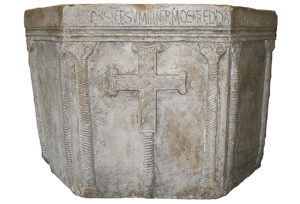 The crucial event which preceded the founding of the dynasty and was of great importance to the whole surrounding area took place in the 6th century, when Slavic tribes started arriving to the Balcan peninsula. One of the tribes were Croats who settled in the former Roman province of Dalmatia where romanised Illyrian tribes had lived through a longer period of time and with whom they established more or less peaceful relation. This roman speaking community and Croatian tribesmen diversed only regarding the concept of acceptance of Christianity which was a long and ongoing process for arrived population. One example of this process is Višeslav baptistery presumably originating from the beginning of the 9th century when, according to some historians, this Croatian duke ruled the coastal Dalmatian region nearby Nin municipal.1
The crucial event which preceded the founding of the dynasty and was of great importance to the whole surrounding area took place in the 6th century, when Slavic tribes started arriving to the Balcan peninsula. One of the tribes were Croats who settled in the former Roman province of Dalmatia where romanised Illyrian tribes had lived through a longer period of time and with whom they established more or less peaceful relation. This roman speaking community and Croatian tribesmen diversed only regarding the concept of acceptance of Christianity which was a long and ongoing process for arrived population. One example of this process is Višeslav baptistery presumably originating from the beginning of the 9th century when, according to some historians, this Croatian duke ruled the coastal Dalmatian region nearby Nin municipal.1
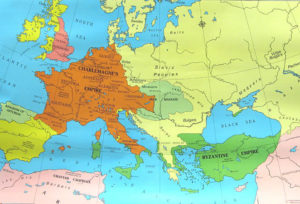 After almost two centuries of peaceful coexistence of two entities a war broke out between Franks and Byzantium in the Adriatic sea, which influenced a development of coastal municipals with Roman background who felt threatened despite being under direct control and protection of the Byzantine Empire. Due to neither side having the means of gaining advantage int he war activities, a peace agreement was signed in Aachen in 812 by which both sides agreed to keep their conquerred territories. Istria and Croatia were therefore occupued by Franks, while Byzantines kept Dalmatian municipality and Venice. Distinction between coastal area and continental background as consequence of this peace treaty remained and superceded both Frankish and Byzantine government in later years.2
After almost two centuries of peaceful coexistence of two entities a war broke out between Franks and Byzantium in the Adriatic sea, which influenced a development of coastal municipals with Roman background who felt threatened despite being under direct control and protection of the Byzantine Empire. Due to neither side having the means of gaining advantage int he war activities, a peace agreement was signed in Aachen in 812 by which both sides agreed to keep their conquerred territories. Istria and Croatia were therefore occupued by Franks, while Byzantines kept Dalmatian municipality and Venice. Distinction between coastal area and continental background as consequence of this peace treaty remained and superceded both Frankish and Byzantine government in later years.2
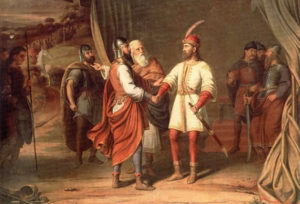 Administrative structure was based upon military composed territorial units: counties (ruled by count) and duchies (ruled by duke) on Frankish and themes on Byzantine side. Soon first conflicts were aroused and Ljudevit, Panonnian duke, led a rebellion against Frankish authorities, his intention was to implement their version of feudal regulation through Margrave of Friuli. Carantania in the west and Timochans int he east allied with Ljudevit; through influence of Aquileian patriarch Fortunato he was also able to maintain friendly relation with the Byzantines, but was denied support from his southern neighbor Borna, duke of Liburnia and Dalmatia.3 This local ruler depended on Franks as the outcome of Aachen peace treaty made possible for Byzantium to retain influence and impact to the region through Dalmatian towns, making it a potentially dangerous situation for lands ruled over by Borna. At the very beginning of his mutiny Ljudevit soon faced two armies against his efforts: Frankish and the one led by duke Borna who tried to maneuver across river Kupa and into the territory controlled by Ljudevit’s forces. In a bloody battle that took place near Kupa Borna was defeated and his life was saved only by a quick reaction of his praetorian guard.4 Ljudevit then organized counteroffensive, went ahead and penetrated into Borna’s lands burning and pillaging everything in his path. Borna decided to use most of his forces to protect the fortified communes and residential areas and the rest of his forces took initiative and inflicted great damage to Ljudevit’s army in a suprise attack.5
Administrative structure was based upon military composed territorial units: counties (ruled by count) and duchies (ruled by duke) on Frankish and themes on Byzantine side. Soon first conflicts were aroused and Ljudevit, Panonnian duke, led a rebellion against Frankish authorities, his intention was to implement their version of feudal regulation through Margrave of Friuli. Carantania in the west and Timochans int he east allied with Ljudevit; through influence of Aquileian patriarch Fortunato he was also able to maintain friendly relation with the Byzantines, but was denied support from his southern neighbor Borna, duke of Liburnia and Dalmatia.3 This local ruler depended on Franks as the outcome of Aachen peace treaty made possible for Byzantium to retain influence and impact to the region through Dalmatian towns, making it a potentially dangerous situation for lands ruled over by Borna. At the very beginning of his mutiny Ljudevit soon faced two armies against his efforts: Frankish and the one led by duke Borna who tried to maneuver across river Kupa and into the territory controlled by Ljudevit’s forces. In a bloody battle that took place near Kupa Borna was defeated and his life was saved only by a quick reaction of his praetorian guard.4 Ljudevit then organized counteroffensive, went ahead and penetrated into Borna’s lands burning and pillaging everything in his path. Borna decided to use most of his forces to protect the fortified communes and residential areas and the rest of his forces took initiative and inflicted great damage to Ljudevit’s army in a suprise attack.5
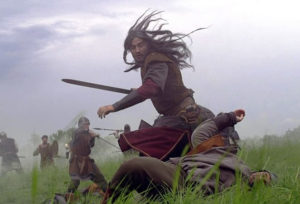 After five years of fighting during which some of the deployed Frankish armies were decimated due to poor health conditions and diseases, Ljudevit finally had to withdraw his forces and retreated into exile himself, mostly because of defeat and surrender of his allied troops which changed the odds that were until then still in his favor. Ljudevit found shelter amongst occupants of Srb (possibly community placed south of present-day Bihać, near river Una), soon after overthrowing one oft he local dukes and killing him. After a while he was forced to flee from there and found shelter at Ljudemisl, Borna’s uncle who soon captured Ljudevit by surprise and executed him.6 The importance of Ljudevit for the Croatian history lies int he fact that he ruled over Lower Panonia, land that will soon become part of the early medieval Croatian Kingdom. Duke Borna died at 821. His most important achievement was connecting his semi-autonomus state with Carolinian, Western European cultural circle which was of crucial importance for the future development of Croatia. Borna was succeeded by his nephew Vladislav with the approval of the people and the official confirmation given to him by his nominal sovereign, emperor Louis the Pious (814-840).
After five years of fighting during which some of the deployed Frankish armies were decimated due to poor health conditions and diseases, Ljudevit finally had to withdraw his forces and retreated into exile himself, mostly because of defeat and surrender of his allied troops which changed the odds that were until then still in his favor. Ljudevit found shelter amongst occupants of Srb (possibly community placed south of present-day Bihać, near river Una), soon after overthrowing one oft he local dukes and killing him. After a while he was forced to flee from there and found shelter at Ljudemisl, Borna’s uncle who soon captured Ljudevit by surprise and executed him.6 The importance of Ljudevit for the Croatian history lies int he fact that he ruled over Lower Panonia, land that will soon become part of the early medieval Croatian Kingdom. Duke Borna died at 821. His most important achievement was connecting his semi-autonomus state with Carolinian, Western European cultural circle which was of crucial importance for the future development of Croatia. Borna was succeeded by his nephew Vladislav with the approval of the people and the official confirmation given to him by his nominal sovereign, emperor Louis the Pious (814-840).
Peaceful period between Ljudevit’s uprising and Trpimir’s succession was interrupted by a conflict between the city of Venice and the pirates of the banks of river Neretva. Neretvans had support from Croats, so Venetian Doge Pietro Tradonico (837-864) started a war not only against Neretvanean duke but also against Croatian duke Mislav. Although Neretvans made a few promises and from time to time stopped attacking Venetian traders they repeatedly went back to piracy and broke their given word. Venetian Doge Pietro Tradonico and duke Mislav met in St. Martin in 839 and negotiated a first ever known peace treaty between a Venetian Doge and a Croatian ruler.7 This meeting is the oldest mention of Mislav in any written source, so we can’t be sure whether he was related by blood with Borna and his successors.
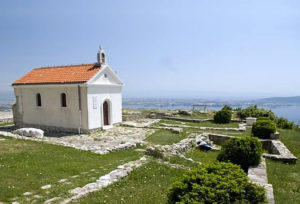 Preserved material evidence from the time of his reign is the church of St. George in Putalj which duke Mislav personally donated to the archbishop of Split. Mislav died after 840 and his time marked the beginning of rise and consolidation of the young Croatian state. His successor, Trpimir, will later become the founder of a dynasty later known as Trpimirović and is remembered as one of the greatest rulers in Croatian medieval history.
Preserved material evidence from the time of his reign is the church of St. George in Putalj which duke Mislav personally donated to the archbishop of Split. Mislav died after 840 and his time marked the beginning of rise and consolidation of the young Croatian state. His successor, Trpimir, will later become the founder of a dynasty later known as Trpimirović and is remembered as one of the greatest rulers in Croatian medieval history.
Other articles from the series: “The Trpimirović Dynasty of Croatian Rulers”
- From the Arrival and Settling of Croats to Trpimir Ascending to the Throne
- The age of duke Trpimir
- Dukes Domagoj and Zdeslav
- Branimir and Muncimir
- The age of kings – Tomislav
- Church Councils and King Tomislav’s Heirs
- Stjepan Držislav
- The Heirs of Stjepan Držislav
- Petar Krešimir IV
- Demetrius Zvonimir
- Demetrius Zvonimir and Stephen II
- With a help from his numerous allies from Upper Austria all the way up to the river Timok, duke Ljudevit raised an uprising and resisted Francia, the greatest military power of that time.
- In the battle near river Kupa, duke Borna’s life was saved by his praetorian guard.
- At 820 duke Borna was hosted by the Frankish emperor Louis the Pious and participated in debates about further actions against Ljudevit.
- Neven BUDAK, Prva stoljeća Hrvatske, Zagreb: Hrvatska sveučilišna naklada, 1994
- Ivo GOLDSTEIN, Hrvatski rani srednji vijek, Zagreb: Novi Liber – Zavod za hrvatsku povijest FF-a, 1995
- Radoslav KATIČIĆ, Pretorijanci kneza Borne, Starohrvatska prosvjeta 20 (1990), page 65-83.
- Nada KLAIĆ, Povijest Hrvata u ranom srednjem vijeku, Zagreb: Školska knjiga, 1971
- Tadija SMIČIKLAS, Poviest hrvatska, book one, Zagreb: Matica hrvatska, 1882
- Ferdo ŠIŠIĆ, Povijest Hrvata u vrijeme narodnih vladara, Zagreb: Nakladni zavod Matice hrvatske, 1925
- 1 Ivo GOLDSTEIN, Hrvatski rani srednji vijek, Zagreb: Novi Liber – Zavod za hrvatsku povijest FF-a, 1995, page 233-234.
- 2 Neven BUDAK, Prva stoljeća Hrvatske, Zagreb: Hrvatska sveučilišna naklada, 1994, page 16.
- 3 Nada KLAIĆ, Povijest Hrvata u ranom srednjem vijeku, Zagreb: Školska knjiga, 1971, page 208-211.
- 4 In that battle his life saved people from his closest accompaniment. More details in: Radoslav KATIČIĆ, Pretorijanci kneza Borne, Starohrvatska prosvjeta 20 (1990), page 65-83.
- 5 Tadija SMIČIKLAS, Poviest hrvatska, Book 1, Zagreb: Matica hrvatska, 1882, page 172.; N. KLAIĆ, Povijest Hrvata u ranom srednjem vijeku…, page 210.
- 6 Nada KLAIĆ, Povijest Hrvata u ranom srednjem vijeku, Zagreb: Školska knjiga, 1971, page 211, note 113-115.
- 7 Ferdo ŠIŠIĆ, Povijest Hrvata u vrijeme narodnih vladara, Zagreb: Nakladni zavod Matice hrvatske, 1925, page 327-328.
Very interesting as I learnt what happened in that part of the world during Carolingean times. Je ne savais pas que Venise déjà se profilait dans les relations croates pour assurer la sécurité de son commerce maritime.